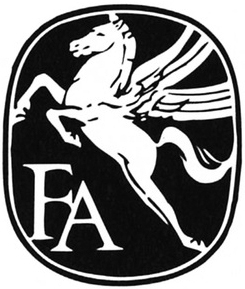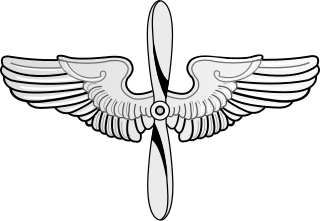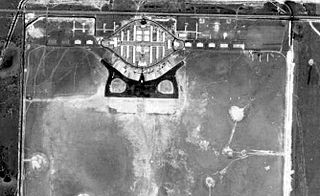Related Research Articles

Fairchild was an American aircraft and aerospace manufacturing company based at various times in Farmingdale, New York; Hagerstown, Maryland; and San Antonio, Texas.

The Curtiss JN "Jenny" was a series of biplanes built by the Curtiss Aeroplane Company of Hammondsport, New York, later the Curtiss Aeroplane and Motor Company. Although the Curtiss JN series was originally produced as a training aircraft for the US Army, the "Jenny" continued after World War I as a civil aircraft, as it became the "backbone of American postwar [civil] aviation".

Curtiss Aeroplane and Motor Company was an American aircraft manufacturer originally founded by Glenn Hammond Curtiss and Augustus Moore Herring in Hammondsport, New York. After significant commercial success in its first decades, it merged with the Wright Aeronautical to form Curtiss-Wright Corporation.

The Naval Aircraft Factory (NAF) was established by the United States Navy in 1918 in Philadelphia, Pennsylvania. It was created to help solve aircraft supply issues which faced the Navy Department upon the entry of the U.S. into World War I. The US Army’s requirements for an enormous quantity of airplanes created a decided lack of interest among aircraft manufacturers in the Navy's requirements for a comparatively small quantity of aircraft. The Navy Department concluded that it was necessary to build a Navy-owned aircraft factory in order to assure a part of its aircraft supply; to obtain cost data for the department’s guidance in its dealings with private manufacturers; and to have under its own control a factory capable of producing experimental designs.

The Fairchild PT-19 is an American monoplane primary trainer aircraft that served with the United States Army Air Forces, RAF and RCAF during World War II. Designed by Fairchild Aircraft, it was a contemporary of the Kaydet biplane trainer, and was used by the USAAF during Primary Flying Training. As with other USAAF trainers of the period, the PT-19 had multiple designations based on the powerplant installed.

The United States Army Air Service (USAAS) was the aerial warfare service component of the United States Army between 1918 and 1926 and a forerunner of the United States Air Force. It was established as an independent but temporary branch of the U.S. War Department during World War I by two executive orders of President Woodrow Wilson: on May 24, 1918, replacing the Aviation Section, Signal Corps as the nation's air force; and March 19, 1919, establishing a military Director of Air Service to control all aviation activities. Its life was extended for another year in July 1919, during which time Congress passed the legislation necessary to make it a permanent establishment. The National Defense Act of 1920 assigned the Air Service the status of "combatant arm of the line" of the United States Army with a major general in command.

Antony Habersack Jannus, more familiarly known as Tony Jannus, was an early American pilot whose aerial exploits were widely publicized in aviation's pre-World War I period. He flew the first airplane from which a parachute jump was made, in 1912. Jannus was also the first airline pilot, having pioneered the inaugural flight of the St. Petersburg–Tampa Airboat Line on January 1, 1914, the first scheduled commercial airline flight in the world using heavier-than-air aircraft. The Tony Jannus Award, created to perpetuate his legacy, recognizes outstanding individual achievement in the scheduled commercial aviation industry and is conferred annually by the Tony Jannus Distinguished Aviation Society founded in Tampa, Florida, in 1963.

Tubal Claude Ryan was an American aviator born in Parsons, Kansas. Ryan was best known for founding several airlines and aviation factories.
Sherman Mills Fairchild was an American businessman and investor who founded over 70 companies, including Fairchild Aviation, Fairchild Industries, and Fairchild Camera and Instrument. Fairchild made significant contributions to the aviation industry and was inducted into the National Aviation Hall of Fame in 1979. His Semiconductor Division of Fairchild Camera played a defining role in Silicon Valley. He held over 30 patents for products ranging from the silicon semiconductor to the 8-mm home sound motion-picture camera. Fairchild was responsible for inventing the first synchronized camera shutter and flash as well as developing technologies for aerial cameras that were later used on the Apollo Missions.

The Aviation Section, Signal Corps, was the aerial warfare service of the United States from 1914 to 1918, and a direct statutory ancestor of the United States Air Force. It absorbed and replaced the Aeronautical Division, Signal Corps, and conducted the activities of Army aviation until its statutory responsibilities were suspended by President Woodrow Wilson in 1918. The Aviation Section organized the first squadrons of the aviation arm and conducted the first military operations by United States aviation on foreign soil.

St. Louis Downtown Airport is a public-use airport located in Greater St. Louis, one mile (2 km) east of the central business district of Cahokia Heights, in St. Clair County, Illinois, United States. It is owned by the Bi-State Development Agency. The airport is located less than 3 miles from the Gateway Arch riverfront in St. Louis and is used by many business aircraft visiting the St. Louis region. Airport services include one full-service 24-hour fixed-base operator, an instrument landing system, an FAA air traffic control tower, and its own dedicated Index B aircraft rescue and firefighting (ARFF) service. It is utilized mainly by Saint Louis University's Parks College of Engineering, Aviation and Technology for training purposes, as well as the St. Louis Cardinals for charter flights to away games.
The Benoist Aircraft Company was an early manufacturer of aircraft in the United States. It was formed in 1912 in St Louis, Missouri, by Thomas W. Benoist. Over the next five years, it would build 106 aircraft, including Benoist XIVs that would be used for the first heavier-than-air airline service. The company dissolved with Tom Benoist's accidental death in 1917.

The 116th Air Refueling Squadron is a unit of the Washington Air National Guard 141st Air Refueling Wing located at Fairchild Air Force Base, Spokane, Washington. The 116th is equipped with the KC-135R Stratotanker and RC-26B Metroliner.

The 110th Bomb Squadron is a unit of the Missouri Air National Guard 131st Bomb Wing located at Whiteman Air Force Base, Knob Noster, Missouri. The 110th is equipped with the Northrop Grumman B-2 Spirit.

The Western Antique Aeroplane and Automobile Museum (WAAAM) is located in Hood River, Oregon, United States, adjacent to the Ken Jernstedt Memorial Airport. WAAAM is a nonprofit 501(c)(3) organization committed to the preservation of, and education about aviation, automobile, and other historic transportation-related relics.

Dorr Field is a former military airfield, located 12 miles (19 km) east of Arcadia, Florida. The airfield was one of thirty-two Air Service training camps established in 1917 after the United States entry into World War I.

Hicks Field is a former World War I military airfield, located 5.6 miles (9.0 km) North-northwest of Saginaw, Texas. It operated as a training field for the Air Service, United States Army between 1917 until 1920. It was one of thirty-two Air Service training camps established after the United States entry into World War I in April 1917.

Thomas W. Benoist was an American aviator and aircraft manufacturer. In an aviation career of only ten years, he formed the world's first aircraft parts distribution company, established one of the leading early American aircraft manufacturing companies and a successful flying school, and from January to April 1914 operated the world's first scheduled airline.
Major William Bryan Robertson was an American aviator and aviation executive who was the co-founder of Lambert-St. Louis Flying Field as well as the owner and President of Robertson Aircraft Corporation (RAC) located there, a company which he had co-founded with his brother, Frank, in 1918.
The Fowler Airplane Corporation was an aircraft manufacturing company that operated in San Francisco, California, from 1918 into the 1920s. It was founded by Robert G. Fowler, the first person to make a west-to-east transcontinental flight in stages.
References
- ↑ Jeremy R Cox. St. Louis Aviation.
- ↑ "Thomas Benoist and the World's First Airline". Gateway News. November 1984.
- ↑ Aerial age, Volume 8.
- ↑ Congressional edition, Volume 7768 By United States. Congress.
- ↑ Aerospace Industries Association of America. Aircraft yearbook.
- ↑ United States. Congress. House. Select Committee on Expenditures in the War Department. War expenditures: hearings before subcommittee no. 1, Volume 3.
- ↑ David Mondey (1978). The complete illustrated encyclopedia of the world's aircraft .
- ↑ Airway age Volume 11. 1930.
- ↑ Aerospace Industries Association of America Aeronautical Chamber of Commerce of America (1936). Flying Volume 4.
- ↑ "St.Louis Cardinal". Archived from the original on 3 September 2011. Retrieved 16 September 2011.
- ↑ Richard Stewart KirKendall. A History Of Missouri: 1919 To 1953.
- ↑ William Earl Parrish; William E. Foley; Richard S. Kirkendall; Perry McCandless. A History of Missouri: 1919 to 1953.